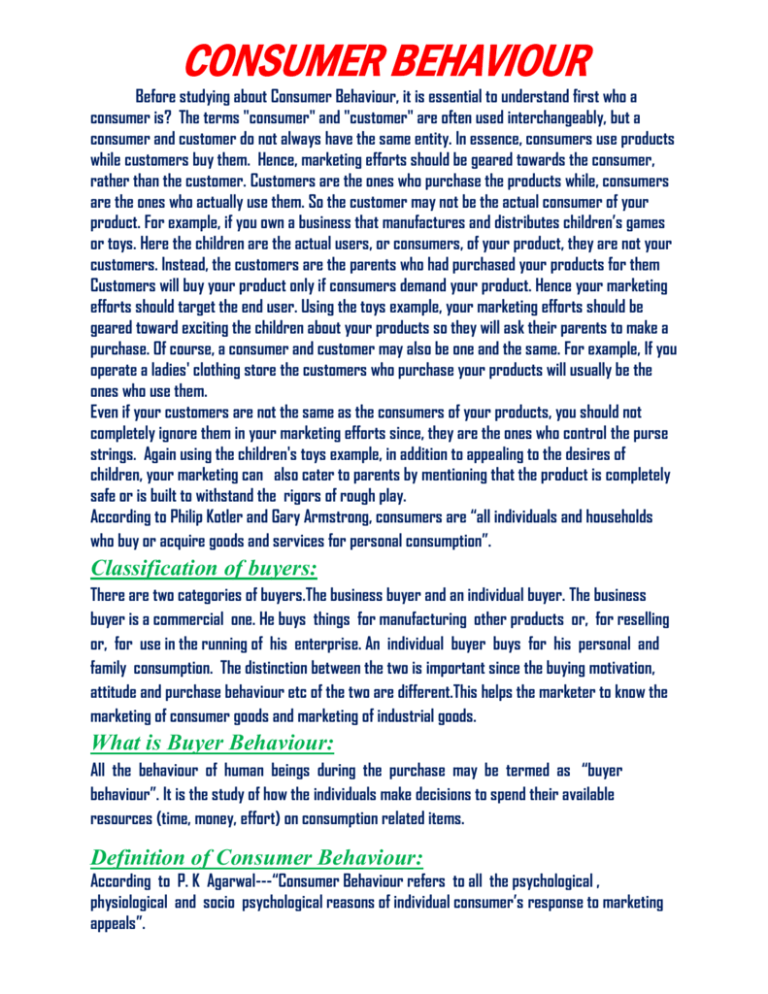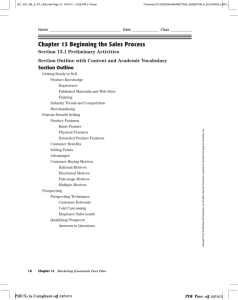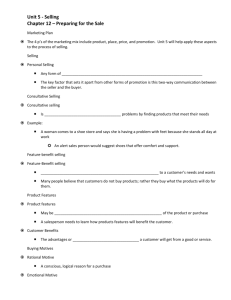File - the notes of comk class
advertisement

CONSUMER BEHAVIOUR Before studying about Consumer Behaviour, it is essential to understand first who a consumer is? The terms "consumer" and "customer" are often used interchangeably, but a consumer and customer do not always have the same entity. In essence, consumers use products while customers buy them. Hence, marketing efforts should be geared towards the consumer, rather than the customer. Customers are the ones who purchase the products while, consumers are the ones who actually use them. So the customer may not be the actual consumer of your product. For example, if you own a business that manufactures and distributes children’s games or toys. Here the children are the actual users, or consumers, of your product, they are not your customers. Instead, the customers are the parents who had purchased your products for them Customers will buy your product only if consumers demand your product. Hence your marketing efforts should target the end user. Using the toys example, your marketing efforts should be geared toward exciting the children about your products so they will ask their parents to make a purchase. Of course, a consumer and customer may also be one and the same. For example, If you operate a ladies' clothing store the customers who purchase your products will usually be the ones who use them. Even if your customers are not the same as the consumers of your products, you should not completely ignore them in your marketing efforts since, they are the ones who control the purse strings. Again using the children's toys example, in addition to appealing to the desires of children, your marketing can also cater to parents by mentioning that the product is completely safe or is built to withstand the rigors of rough play. According to Philip Kotler and Gary Armstrong, consumers are “all individuals and households who buy or acquire goods and services for personal consumption”. Classification of buyers: There are two categories of buyers.The business buyer and an individual buyer. The business buyer is a commercial one. He buys things for manufacturing other products or, for reselling or, for use in the running of his enterprise. An individual buyer buys for his personal and family consumption. The distinction between the two is important since the buying motivation, attitude and purchase behaviour etc of the two are different.This helps the marketer to know the marketing of consumer goods and marketing of industrial goods. What is Buyer Behaviour: All the behaviour of human beings during the purchase may be termed as “buyer behaviour”. It is the study of how the individuals make decisions to spend their available resources (time, money, effort) on consumption related items. Definition of Consumer Behaviour: According to P. K Agarwal---“Consumer Behaviour refers to all the psychological , physiological and socio psychological reasons of individual consumer’s response to marketing appeals”. According to Philip Kotler and Armstrong--- “ Consumer Behaviour refers to the buying behaviour of individuals and households who buy goods and services for personal consumption ”. According to J.F Engel ----“ Consumer Behaviour can be defined as the activities and the actions of people and organization that purchase and use economic goods and services, including the influence on these activities and actions”. Need and importance for studying Consumer Behaviour: The buyer behaviour is studied to predict buyers’ reaction in markets. As a matter of fact, customer is the pivot around which the whole industrial of nowadays revolves. Customer is the ‘king’. His selection of goods or service determines the fate of products / services. Hence in order to attract him more and more, the marketers should know their customers well so that they could treat them in the way they like to be treated, present the goods in the way, they will appreciate and close a sale in such a way that consumer satisfaction is created. Following points will tell you the need for studying Consumer Behavior. 1. Helps in Planning and implementation:- Knowledge of consumer behavior will be of great help to the marketer. He can understand consumer’s reaction to a firm’s marketing strategies. It would help them in planning and implementing marketing strategies.It is useful in developing ways for more utilization of resources of marketing, and thus helps in solving marketing management problems in a very effective manner. 2. Helps to gain consumer confidence: A study on consumer behavior answers the following questions. (i) Who constitute the market? ---------------- Occupants (ii) What does the market buy? ---------------- Objects of purchase (iii) Why does the market buy? ---------------- Objectives of purchase (iv) Who participates in buying? ----------------- Organizations of Purchasing (v) How does the market buy? ------------------ Operations of purchasing organization (vi) When does the market buy? ------------------ Occasion for purchase (vii) Where does the market buy? ------------------- Outlets for purchase. Having the answer to these questions will help you to gain consumer confidence.You may have the best product, but the consumer does not know this. You will speak to them through your packaging, your status in the community, your good-will, your price points and the way your product relates to them. These factors will help to determine who will become your customers and who won't. 3. Helps to understand psychology of customers: The study of consumer behavior enables the marketers to understand the psychology of consumers. Consumer psychology is based on his knowledge, attitude, intention and motive. Attitude is a state of mind or feeling and, intention is a desire to do something. A marketing programme is formulated after understanding the intention of consumers. Promotion plays an important role to provide the knowledge of the product to consumers 4. Helps to understand the buying motives:- Knowledge of consumer behavior enable the marketers to understand the buying motives of a consumer A motive is an inner urge that moves or prompts a person to action. Consumers have several motives. All these motives do not have the same intensity of purchase. Only a few motives prompt the consumer to buy a product or service. Thus understanding buying motives will help the marketers for effective market segmentation and target marketing. 5. Helps to understand consumers choices: It is Important for the marketer to understand how consumers make their choices. Consumers make systematic use of information available to them before they buy. A marketer studies their behaviour and accordingly alter their presentation, enticing the customer to go for the product. 6. Helps in formulating production policy: Consumers’ tastes and preferences are ever changing. Study of consumer behavior gives information regarding colour, design,size etc. which consumers want. In short, study of consumer behaviour helps in formulating production policy.A business firm which is ignorant of consumer preferences cannot succeed in the market place. So a firm must plan its production and distribution to suit the needs of consumers. 7. Helps in shaping the fortunes of the organization: Consumers have needs and wants, and the objective is to identify the need and create the want. The ultimate goal is to influence consumer behavior and convert this into profits for the company. Businesses that can predict consumer behavior will have the edge over their competitors. To predict consumer behavior requires knowledge of their values, goals and lifestyle. Companies with this asset use it to develop better strategies, and are better able to win over consumers. Thus the study of consumer behaviour for any product is of vital importance to marketers in shaping the fortunes of their organisations. 8. Helps to understand the upcoming group of customers: Today consumers give more importance on environment friendly products. They are concerned about health, hygiene and fitness. They prefer natural products. Hence detailed study on upcoming groups of consumers is essential for any firm.The growth of consumer protection movement has created an urgent need to understand how consumers make their consumption and buying decision Buying Motives When a consumer purchases a particular product, he has a reason for it.. Motive is a strong feeling, urge, instinct, desire or emotion that makes the buyer buy a particular product or service. It is a drive or an urge for which an individual seeks satisfaction. Any urge promoting a person to decide to buy a particular product is called a buying motive. Definitions of buying motives Buying motives are defined as follows; 1. “A motive is an inner urge that moves or prompts a person to action”. – R. S. Davar 2. “A motive maybe defined as a drive or an urge for which an individual seeks satisfaction. It becomes a buying motive when the individual seeks satisfaction through the purchase of something”. – W. J. Stanton 3. “Buying motives are those influences or considerations which provide the impulse to buy, induce action or determine choice in the purchase of goods or services”. – D.J. Durian Classification of Buying Motives Buying motive are broadly classified into two :(1) Product Motives and (2) Patronage motives. Product motives include emotionalBUYING productMOTIVES motives and rational product motives. Patronage motives consist of emotional patronage motives and rational patronage motives. PRODUCT MOTIVES EMOTIONAL I Product Motives: PATRONAGE MOTIVES RATIONAL EMOTIONAL RATIONAL Product buying motives refer to those influences and reasons, which prompt (i.e. induce) a buyer to choose a particular product in preference to other products. They include the physical attraction of the product (i.e. the design, shape, dimension, size, colour, package, performance, EMOTIONAL price etc. of the product) or the psychological attraction of the product. In short, they refer to all those characteristics of a product, which induce a buyer to buy it in preference to other products Product buying motives are those that promoteEMOTIONAL the consumer or propel him and impel to buy because of physical and psychological product attributes. These physical and psychological attractions may be designed, size, color, taste, package, price, performance, pride, affection, durability, suitability, versatility, safety, comfort economy, convenience and so on. These productbuying motives may be either ‘emotional’ or ‘rational’. . Product buying motives may be sub-divided into two groups, viz.,(i) emotional product buying motives and (ii) rational product buying motives. (i) Emotional Product buying Motives: When a buyer decides to purchase a product without thinking over the matter logically and carefully (i.e., without much reasoning), she / he is said to have been influenced by emotional product buying motives. Emotional product buying motives urge the customers to be distinctive. Emotional product motives consists of those impulses which appeal to buyers pride or ego. Here are few examples For instance, diamond merchants sell their products by suggesting to the buyers that the possession of diamonds increases their prestige or social status a) Pride or Prestige : For instance, a housewife may like to have a silk sari for the simple reason that all the neighbouring housewives have silk saris. b) Imitation : For instance, a husband may buy a costly silk sari for his wife or a father buy a costly watch for his son or daughter out of his affection and love. c) Affection : d) Desire for comfort, individuality, ambition, recreation are other reasons for emotional buying motives. In short, consumers prompted by emotional motives buy a certain product without evaluating the pros and cons of such action. Emotional product motives can be: pride in appearance desire to feel important love of family desire for comfort curiosity convenience desire for security health safety fear Pride--Vanity Jealousy Fashion or imitation Sex--Habits--Love and affection--Comfort--Aesthetic pleasure--Praise desire for recognition (ii) Rational Product Buying Motive: When a buyer decides to buy a certain thing after careful consideration (i.e. after thinking over the matter consciously and logically), she / he is said to have been influenced by rational product buying motives. The buyer carefully evaluates the plus and minus points of the product or services which he intends to buy. The price of the product, the benefits that a product offers, the various alternative product available to the buyer are considered before a product or service is bought.. Rational product motives totally justify the purchase of a product or service. Customers who are influenced by rational product motives considers the following : safety and security of the product., Economy. Relatively low price, suitability, utility, durability ,convenience etc. Rational product motives can be: Safety or fear Suitability--Durability--Economy--Convenience--Versatility Profit or cupidity Curiosity Recreation--Hobbies economy in purchase and use efficient performance durability increased profits ease of installation increased production availability low maintenance cost thoroughly researched and tested time-saving labour-saving II Patronage Motives: : Patronage buying motives refer to those considerations or reasons, which prompt a buyer to buy the product wanted by him from a particular shop in preference to other shops. What are the impulses that persuades him to do so?.Patronage motives can also be classified into (i) Emotional patronage motives and (ii) Rational Patronage Motives. (i) Emotional Patronage Motives: Emotional patronage motives persuade a buyer to buy from a specific shop. Not much logical reasoning is behind this action. The buyer considers the shop as his favorite shopping place. He is in the habit of regularly visiting the shop. Emotional patronage buying motives include the following. Appearance of the shop, ,display of the goods, recommendations, prestige, habit etc. Patronage emotional motives are based on his wish or emotion or pulsive attitude. His decision to support a store is not the outcome of reasoning and judgment. His selection is founded on the casual factors and these are: Emotional patronage motives can be: Appearance of the store-- Recommendations of friends and relatives-- Imitation-- Prestige-- Habit---. (ii) Rational Patronage Motives: When a buyer patronises a shop after careful consideration (i.e. after much logical reasoning and careful thinking) he is said to have been influenced by rational patronage buying motives. For eg. patronage based on a wide selection, latest models, convenience, good after sales service , credit facilities etc offered by a shop. Classification of buying motives into ‘emotional’ and ‘rational’ is filled with certain difficulties. A strict compartmentalization of product motives is not always practical. Sometimes, even emotional motives are based on logical reasoning. A buyer may be under a compulsion to buy impulsively. So, one needs to consider these limitations while classifying buying motives. All customers are not emotional in supporting a particular store. They are rational. They think and judge before extending loyalty to a particular store. The motives of this kind can be: Rational patronage motives can be: Proximity--Widest assortment Credit facilities--Treatment--Services offered--- Motives (Drives) And Needs In the words of Kotler, “a motive is a need that is sufficient to direct a person to seek satisfaction”. In other words, needs are the motivational elements behind purchase. Psychologists have developed theories of human motivation. There are two popular theories of motivation: 1. Sigmund Freud’s theory of motivation. 2. Maslow’s theory of motivation. 1. Freud’s Theory of Motivation: Freud assumed that people are largely not conscious of the real psychological forces shaping their behavior. A person as he grows represses (put down by force) many urges. These urges are never eliminated. They emerge in dreams, in slips of the tongues and in obsessive behavior. Motivation researchers collect in-depth information from consumers .Then they uncover the deeper motives for their product choices. 2. Maslow’s theory of motivation: Maslow’s theory is known as hierarchy of needs. Human needs are arranged in a hierarchy –from the most basic needs to more complex needs. They are arranged in the order of importance. .A person tries to satisfy the most important need first and then the next need. The needs goes in that order, (i) Physiological needs : basic needs of human being ( food, shelter, clothing etc) (ii) Safety needs : such as personal and financial security, safety against accidents and health etc (iii) Social needs : love, affection, belongingness, acceptance etc (iv) Esteem needs : self respect, self valued, recognition etc: (v) self actualization needs : This need pertains to what a person's full potential is and realizing that potential. Maslow describes this desire as the desire to become what one is capable of becoming . Few examples of buying motives for few products: 1. Motor bike: Emotional: Pride, comfort Rational: durability, low maintenance cost, time saving, economy in purchase and use 2. Helmet: Rational: health, convenience. Suitability, durability, economy Emotional: Safety, fear,





